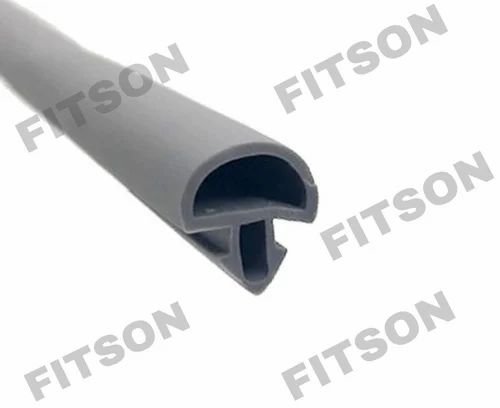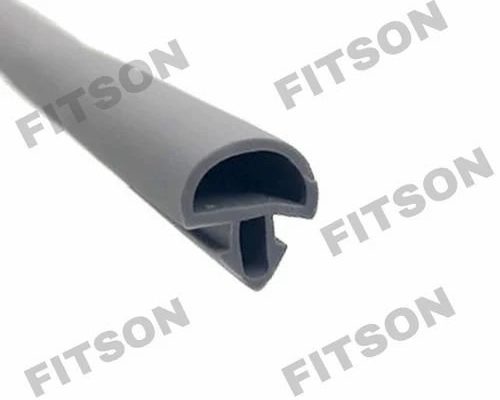
Think of a door gasket as your home’s unsung bouncer. Its job? Let nothing unwanted pass through—whether it’s hot, cold, or dust. But not all gaskets are created equal. If you grab the cheapest one, it might crack, shrink, or turn brittle after a rough winter or brutal summer. That’s why brands like Pemko, Zero International, and Frost King put so much work into their materials. They know it’s all about picking the right stuff for the job.
Let’s break down what really matters when you’re choosing a door gasket to survive everything Mother Nature throws your way. I’ll walk you through the best and worst materials, when to use each, and a few troubleshooting tips if things go sideways.
Why Temperature Swings Wreck Regular Door Gaskets
Not all climates are gentle. In places where it’s sunny one day and snowing the next, the constant expansion and contraction can trash ordinary gaskets. Here’s the thing: most materials aren’t made to handle both bitter cold and blazing heat. They’ll lose their shape, crack, or pull away from the door frame—let’s be honest, totally defeating the point of having them in the first place.
If your gasket starts curling at the edges, turning stiff, or even falling off, that’s often the result of extreme temps. It’s almost like your car battery dying at the worst time—annoying, and, if you rely on your heating or cooling, *expensive*. This is especially true if you have an automatic door or use a smart lock system that syncs with security settings. When gaskets fail, you get more than a draft; you risk messing with your remote entry system or letting in debris that can jam things up.
So before you code in a new passcode, pair a fresh remote, or reset your smart lock, step one should always be: check the gasket. If it looks tired or out-of-shape, it’s probably time for a material upgrade.
EPDM: The Top Choice for Extreme Temperature Fluctuations
If you ask most pros, EPDM (Ethylene Propylene Diene Monomer) is the gold standard for door gaskets in rough climates. This material is basically a superhero when it comes to staying flexible and strong, whether it’s freezing cold or scorching hot outside.
What sets EPDM apart is how it acts a bit like memory foam—always snapping back into shape, no matter how many times the door opens or closes. You might be wondering why that matters. Well, if your gasket can’t “reset” itself, you get leaks. EPDM, on the other hand, resists cracking, shrinking, or warping when the weather swings. It’s also great at handling ozone and UV light, so it doesn’t crumble in the sun.
One more thing: EPDM gaskets are trusted in heavy-duty brands like Pemko and Zero International. These companies use advanced formulas so the material stays soft, seals tight, and doesn’t let you down mid-season. Sure, they cost a bit more, but you’ll spend less time troubleshooting drafts, resealing doors, or replacing gaskets every year.
Silicone Gaskets: Tough Enough for Hot and Cold
Silicone is another favorite for door gaskets where wild temperature changes are the norm. It’s the same stuff that stands up to heat in baking sheets and the cold in freezer trays, so you know it’s going to handle your door just fine. What makes silicone special is its *elasticity*—it basically stretches and bends without breaking down.
Honestly, if you want something that looks neat and lasts through both icy blizzards and summer scorchers, silicone is hard to beat. It stays soft and flexible even when temps swing hard, and that means your seal won’t suddenly fail if there’s a surprise frost or heatwave.
One bonus: silicone gaskets often come in colors that match your door or frame, making them a popular option for folks who care about both performance and aesthetics. Brands like Frost King offer silicone options designed to stick tight and work well with both manual and remote-controlled entry doors.
Foam Gaskets: When to Use Them and When to Avoid
Foam gaskets are everywhere, especially in DIY stores. They’re cheap, easy to cut, and simple to install. But—and here’s where things get real—they’re not built for wild temperature changes. Foam compresses easily, and while that’s great for stopping a small draft, it’s not so great after a winter where temps swing from below zero to a spring thaw.
If you’re using a foam gasket on a door that’s exposed to both heat and cold, expect to troubleshoot issues. The foam can lose its shape fast, turn brittle, or even start breaking apart. That can mess with your door’s code or remote entry system, especially if bits of foam fall into the locking mechanism or block the seal.
Let me explain: foam works best for interior doors or places with mild temperatures. If you live somewhere with extreme weather, consider foam only as a temporary fix. Otherwise, you’ll be replacing it often—not exactly cost-effective or convenient if you like your seals to just work.
Neoprene: Durable but With Limits
Neoprene is a step up from foam and is often found in gaskets marketed for “all-weather” use. It’s the same material used in wetsuits, so you know it handles moisture and a fair bit of temperature change. However, while neoprene is more durable than basic foam, it isn’t quite as tough as EPDM or silicone when it comes to extreme highs and lows.
What does this mean for your door? Neoprene will hold up better than cheaper materials if you have a few cold snaps or heatwaves each year. But over time, especially if your door faces hours of direct sunlight or deep winter freezes, neoprene will start to degrade. It might flatten out, shrink, or become less springy—leading to those same issues with drafts, dust, or trouble syncing your smart lock or remote.
Many “universal fit” gaskets use neoprene since it’s flexible and easy to work with. But if you want something that lasts for years in a place with wild weather, stick with EPDM or silicone for the hard stuff.
Metal-Reinforced Gaskets: When Strength Matters Most
Sometimes you need more than just a seal—you need a gasket that adds real strength to the door itself. Metal-reinforced gaskets (usually with an aluminum or stainless steel carrier) are designed for heavy-duty doors, security setups, or spots that see intense use, like commercial walk-ins or busy external entries.
These gaskets combine a tough metal backbone with an outer layer of EPDM, silicone, or neoprene. The metal helps keep the shape, so the gasket doesn’t shift or sag, even after years of temperature swings. Here’s where they really shine: if you use a remote-control lock, keyless entry, or need your door to “sync” perfectly every time, these gaskets make sure the seal never gets out of alignment.
You won’t find metal-reinforced options as easily at big-box stores—they’re often sold through specialty suppliers or direct from brands like Pemko and Zero International. But if your door is an investment, or you’re constantly troubleshooting misaligned seals, they’re worth the search.
Comparing Permanent vs. Temporary Door Gasket Fixes
You might be wondering: is it really worth spending extra on the “good stuff,” or can you get by with a quick, cheap fix? Let’s break that down with a real-life example. Say you grab a cheap foam gasket and stick it on the door because you need a fast solution—no problem, it might stop the draft for a bit. But next season, when the weather shifts, you’re back to troubleshooting why the house feels chilly or why your smart entry system won’t pair right.
On the other hand, investing in a quality EPDM or silicone gasket means fewer headaches down the road. These materials just last longer and handle resets from expansion and contraction way better. If you use your door daily, have pets or kids running in and out, or rely on any kind of remote entry, permanent solutions are honestly the way to go.
It’s tempting to choose a quick fix, but permanent gaskets save time, money, and troubleshooting in the long run—especially anywhere with wild weather swings.
The Role of Brand and Fit in Extreme Weather Gaskets
Even the best material won’t help if your gasket doesn’t fit right or comes from a cut-rate brand. Well-known companies like Pemko and Zero International have built a reputation for testing their materials in real-world extremes. Their gaskets are cut to fit perfectly, so you don’t get weird gaps or misalignments that ruin the seal.
A gasket that fits weirdly can mess up the “reset” every time the temperature swings, leaving you with drafts or issues syncing your smart lock system. Some brands offer universal options, but if you use a remote, code-based, or automated entry, it’s safer to go with a model made for your door’s exact make and size. Brands like Frost King offer good universal kits, but always double-check compatibility—especially if you’re dealing with extreme temps.
If you need to code, sync, or pair your home’s entry tech with the new gasket, always follow the instructions from both the gasket and device brands. A great fit means less troubleshooting and better long-term performance.
Installation and Maintenance Tips for Lasting Door Gaskets
Let me walk you through a few tips, because even the best door gasket materials need proper install and care to do their job:
- Clean the Door Frame: Dirt or residue makes it tough for the gasket to stick or sit right. Wipe everything down before you start.
- Measure Carefully: Too long and the gasket buckles, too short and you get leaks. Cut a bit longer than needed, test, then trim.
- Check Regularly: Even great materials lose their touch eventually, especially if your door is used a lot or exposed to direct sun. Look for cracks, flattening, or loose spots each season.
- Replace Proactively: If you see issues—don’t wait. Resetting your seal early stops bigger problems with drafts or remote entry glitches later.
Taking care of your gasket is like code maintenance for your smart home tech—keep it in shape, and everything else just works better.
Final Thoughts: Pick Smarter, Stay Comfortable
Honestly, picking the right material for your door gasket in places with extreme temperature swings is one of those little decisions that makes a big difference. When you go with EPDM or silicone from a trusted brand and take the time to install and check it properly, you get years of comfort—and way less troubleshooting down the line.
Don’t settle for the quickest fix unless you really have to. The time and money saved on energy bills, fewer replacements, and working entry systems make premium gaskets worth it. Whether it’s the dead of winter or a steamy summer afternoon, you’ll be glad your door is sealed tight, and your home or business stays just how you like it.
